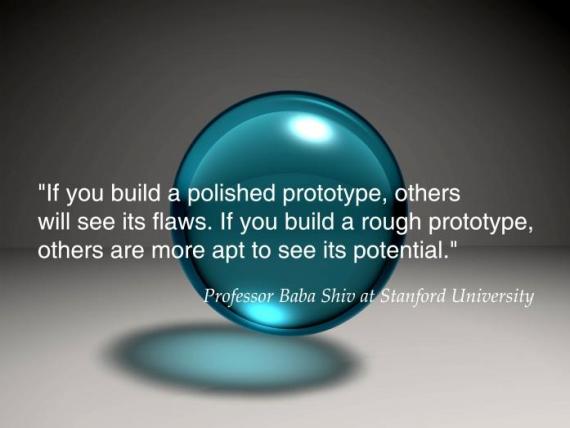
I love the story told by the inventor of the Palm Pilot. When he was getting ready to raise investments, he toured his potential investor groups with a block of wood that had some numbers scribbled on it to look like a keypad. “Now, do you suppose anybody would want to carry something about this size, and they could enter all kinds of data in it — calendar data, phone number data — they could put a lot of data in here and retrieve it at a touch of a button?” the inventor queried each group.
Obviously, you know the end of the story because he did get the investment that he needed.
Now, I want you to imagine the same story, but with him arriving with a finished prototype - that is, something that looked more like an iPhone.
“First, we would press the buttons here, and, then we would press the buttons here, and then we would show this,” the inventor might say. Not a block of wood, but a finished prototype. I can only imagine the discussions which would have then transpired among his investors. “I think the case should be black.” “I think the front should be plastic, not glass.” “I don’t think that’s the right interface you need.” “I don’t think that…“ The conversation would have focused on the details of the prototype rather than the concept of the invention.
Bringing a rough prototype to a group is hard for some leaders. Many leaders like to refine their ideas so when they emerge, they’re almost in concrete. And then, they wonder why they don’t have more buy-in from the stakeholders.
Great leaders have grown in their security so they are comfortable bringing out an unfinished prototype. Consequently, people can get excited about the concept and want to contribute their ideas to the finished prototype or product. We also find that when you allow others to suggest ideas, people don't argue with their own data.
Great leaders have learned to present their ideas, their concepts or their visions before they’re fully cooked. That enables everyone to get involved, and the weight of implementation or persuasion doesn’t fall only on the shoulders of the leader.
As soon as the growing leader understands that people don’t argue with their own data, s/he begins to look for more sophisticated ways to present ideas. Great leaders understand that we as human beings have an almost uncontrollable reflex to correct another person when we sense that person has a misunderstanding of something with which we are knowledgeable (or at least of which we have an opinion).
Consequently, a wise leader may intentionally omit information or point out flaws so that the other parties correct him/her and present a solution. It might sound like this: “You have probably never experienced this problem, so it is not a big deal…”
“Well,” the listener replies, “I have, and it could be a big problem if XYZ happens. Maybe, I need to rethink my recommended course of action.”
The leader has intentionally led the interested parties to say what the leader initially wanted them to realize. Once it becomes the participants’ data, there is no more arguing.
If you enjoyed this post, check out Dave's book, Transforming Leaders the Sandler Way.

